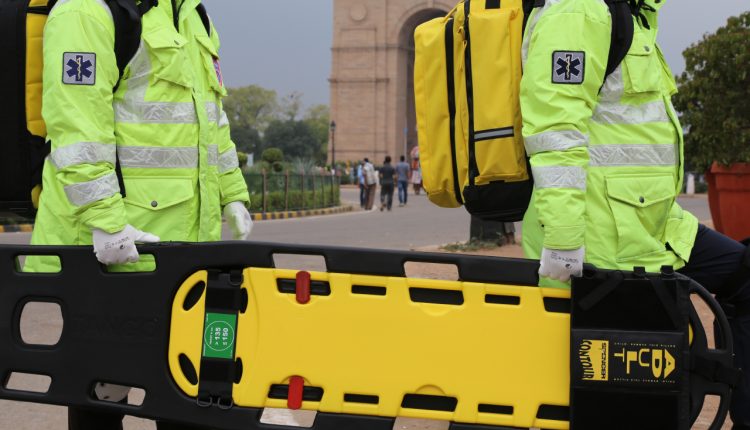
ការធ្វើចលនាឆ្អឹងខ្នង គឺជាបច្ចេកទេសមួយក្នុងចំណោមបច្ចេកទេសដែលអ្នកជួយសង្គ្រោះត្រូវតែធ្វើជាម្ចាស់
Spinal immobilisation is one of the great skills that the emergency medical technician must master. For many years now, all victims who had suffered trauma have been immobilised and, because of the type of accident, according to the technician’s criteria, it was necessary to immobilise the spinal cord
These were the years when it was logical and intuitive to think that any victim of an accident of sufficient magnitude, such as a fall from height, a car accident or a similar event, should be immobilised because there was a risk of spinal cord injury, which we should avoid at all costs.
This included immobilising victims who did not suffer any signs of trauma of any kind, not even ក ឈឺចាប់។
As a general rule, we would immobilise anyone who was involved in an accident, anyone who was involved in a situation that could result in a spinal fracture or spinal cord injury.
THE BEST SPINAL BOARDS? VISIT THE SPENCER BOOTH AT EMERGENCY EXPO
The effects of excessive spinal immobilisation:
This caused hospitals to fill up with victims walking through the door in a neck brace, immobilised on a ក្រុមប្រឹក្សាភិបាល or vacuum mattress, which brought the whole system crashing down.
ឆាប់ៗនេះ បន្ទប់សង្រ្គោះបន្ទាន់ medical staff began to realise that excessive restraint was damaging the hospital’s emergency department.
This led to the development of a series of protocols to determine whether patients walking through the emergency room door met the criteria to undergo radiological techniques to determine whether they had spinal fractures.
Spinal immobilisation: Two main protocols were developed, the Nexus Low Risk Criteria (NLC) and the Canadian C-Spine Rule (CCR)
Both the Nexus and the Canadian protocol sought to exclude patients who did not meet the criteria for diagnostic radiology testing because their clinical diagnosis did not have a well-founded suspicion of spinal cord or spinal cord injury.
These criteria quickly went from being hospital criteria, almost exclusively for radiology, to being used in out-of-hospital medicine to determine which patients should be immobilised in the street and which should not.
There are also other specific criteria for out-of-hospital emergencies, such as the PHTLS criteria, all based on abundant scientific criteria based on statistical research or human experimentation.
A classic example is the experiment in which a group of volunteer subjects were immobilised for long periods of time, between half an hour and two hours, and then asked about possible complications arising from this prolonged immobilisation.
It was then discovered that immobilising a patient generated anxiety and pain in the neck and back that could last for hours, and in some cases could cause skin lesions at the points of support with the board.
Therefore, numerous evidence-based guidelines appeared, such as the NICE 2 guidelines or similar ones.
In August 2018, the American College of Surgeons Committee on Trauma (ACS-COT), the American College of Emergency Physicians (ECEP) and the Association of Emergency Medical Services Physicians (NAEMSP) reached a joint position on what has since been called Spinal Motion Limitation (SMR) 3 .
The following year an interesting article appeared in the Scandinavian Journal of Trauma, Resuscitation and Emergency Medicine entitled “New Clinical Guidelines on Spinal Motion Restriction. The adult trauma patient: consensus and evidence base 4” , published on 19 August 2019.
We can summarise it into its five most important recommendations, four scientific evidence-based recommendations and one algorithm:
- There is strong scientific evidence against applying spinal stabilisation to patients with isolated penetrating trauma, which means it should not be performed.
- The scientific support for immobilising a patient with a stable អាប់ដេត with a spinal board and a rigid spinal កអាវ is weak, which is not recommended to be performed routinely.
- The scientific support for immobilising a patient in a vacuum mattress for transport is weak, i.e. it can be done but there is little evidence in its favour.
- The use of the clinical algorithm is recommended.
បណ្ណាល័យ
- García García, JJ Immobilizzazione cervicale selettiva basata sull'evidenza ។ តំបន់ TES 2014(3):1;6-9។
- Linea guida NIZZA ។ ខែកុម្ភៈ 2016. របួស maggiore: erogazione del servizio. https://www.nice.org.uk/guidance/ng40/chapter/Recommendations
- Peter E. Fischer, Debra G. Perina, Theodore R. Delbridge, Mary E. Fallat, Jeffrey P. Salomone, Jimm Dodd, Eileen M. Bulger & Mark L. Gestring (2018) ការរឹតបន្តឹងចលនាឆ្អឹងខ្នងនៅក្នុងអ្នកជំងឺរបួស - Una dichiarazione di posizione comune, Assistenza preospedaliera di សង្គ្រោះបន្ទាន់, 22:6, 659-661, DOI: 10.1080/10903127.2018.1481476. https://www.tandfonline.com/doi/full/10.1080/10903127.2018.1481476
- Maschmann, Elisabeth Jeppesen, Monika Afzali Rubin និង Charlotte Barfod ។ Nuove linee guida cliniche sulla stabilizzazione spinale dei pazienti adulti con trauma: consenso e prove basate ។ Scandinavian Journal of Trauma, Resuscitation and Emergency Medicine 2019:(27):77។ https://sjtrem.biomedcentral.com/articles/10.1186/s13049-019-0655-x
សូមអានផងដែរ:
Emergency Live រឹតតែខ្លាំង… Live៖ ទាញយកកម្មវិធីឥតគិតថ្លៃថ្មីនៃកាសែតរបស់អ្នកសម្រាប់ IOS និង Android
ភាពមិនដំណើរការនៃឆ្អឹងខ្នង: ការព្យាបាលឬរបួស?
១០ ជំហានដើម្បីអនុវត្តភាពត្រឹមត្រូវនៃឆ្អឹងខ្នងរបស់អ្នកជំងឺដែលមានរបួស
ការរងរបួសជួរឈរឆ្អឹងខ្នង, តម្លៃនៃបន្ទះក្តារឆ្អឹងកង / រ៉ក់ភីនអតិបរមា



